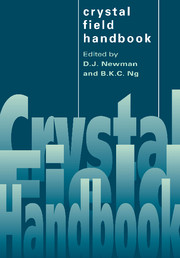Book contents
- Frontmatter
- Contents
- List of contributors
- Preface
- Introduction
- 1 Crystal field splitting mechanisms
- 2 Empirical crystal fields
- 3 Fitting crystal field parameters
- 4 Lanthanide and actinide optical spectra
- 5 Superposition model
- 6 Effects of electron correlation on crystal field splittings
- 7 Ground state splittings in S-state ions
- 8 Invariants and moments
- 9 Semiclassical model
- 10 Transition intensities
- Appendix 1 Point symmetry
- Appendix 2 QBASIC programs
- Appendix 3 Accessible program packages
- Appendix 4 Computer package CST
- Bibliography
- Index
1 - Crystal field splitting mechanisms
Published online by Cambridge University Press: 10 December 2009
- Frontmatter
- Contents
- List of contributors
- Preface
- Introduction
- 1 Crystal field splitting mechanisms
- 2 Empirical crystal fields
- 3 Fitting crystal field parameters
- 4 Lanthanide and actinide optical spectra
- 5 Superposition model
- 6 Effects of electron correlation on crystal field splittings
- 7 Ground state splittings in S-state ions
- 8 Invariants and moments
- 9 Semiclassical model
- 10 Transition intensities
- Appendix 1 Point symmetry
- Appendix 2 QBASIC programs
- Appendix 3 Accessible program packages
- Appendix 4 Computer package CST
- Bibliography
- Index
Summary
In order to interpret the information obtained from magnetic ion spectra using parametrized crystal field models it is necessary to have a qualitative understanding of the physical mechanisms through which the crystalline environment induces energy level splittings. The discussion of mechanisms given in this chapter should be seen in this light. It is not intended to provide a practical basis for quantitative ab initio calculations of crystal field splittings. Instead, it provides a conceptual description of the various mechanisms that contribute to crystal field splittings.
The first three sections give a qualitative description of the most important mechanisms which contribute to crystal field splittings. These comprise the electrostatic, charge penetration, screening, exchange, overlap and covalency contributions. Sections 1.4 and 1.5 express these contributions in terms of a simple algebraic formalism related to the ‘tight-binding’ model in solid state physics. Several other formal approaches to crystal field theory, including the phenomenological approach, are described in the subsequent sections. Numerical results for a particular system, based on the formalism developed in Sections 1.4 and 1.5, are given in Section 1.9. The significance of these results to the phenomenological methods used in this book is summarized in Section 1.10.
The crystal field as a perturbation of free-ion open-shell states
Crystals can be regarded as assemblies of free ions, bound together in several possible ways.
- Type
- Chapter
- Information
- Crystal Field Handbook , pp. 6 - 25Publisher: Cambridge University PressPrint publication year: 2000
- 4
- Cited by

